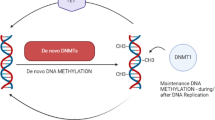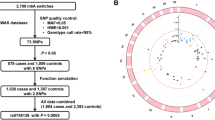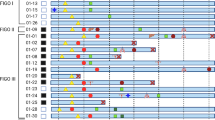Abstract
Purpose
A 11-gene set by methylation-specific PCR in urine sediments for sensitive/specific detection of bladder cancer has been identified previously. In this study, we have evaluated 10 DNA methylation biomarkers that have been reported informative in western countries for bladder cancer diagnosis for a better set.
Materials and methods
The promoter CpG Islands of the following 10 genes: CDH1, FANCF, LOXL1, LOXL4, p16INK4, SFRP1, SOX9, TIG1, TIMP3, and XAF1 have been subjected to methylation-specific PCR analysis in the DNA of 2 bladder cancer cell lines, 2 normal bladder tissues and urine sediments of 82 bladder cancer patients, 15 non-cancerous urogenital patients and 5 healthy volunteers.
Results
Both XAF1 and LOXL1 genes were heterozygously methylated in the normal bladder tissues, showing no cancer state specificity. While the hypermethylated states were detected in urine sediments of bladder cancer at a frequency not less than 2.4% (2/82 cases), nine genes were also methylated in the patients of the non-cancerous urogenital diseases. The methylated SFRP1 was detected in 36.6% (30/82 cases) of bladder cancer and 6.7% (1/15 cases) of non-cancerous urogenital diseases, showing the bladder cancer specificity.
Conclusions
Inclusion of the SFRP1 gene into a set of 11 genes has improved the bladder cancer detection. The insufficiency of predicting disease onset in this study with the previously recommended targets in western countries suggests a possible disease disparity between these two populations. Alternatively, the tissue-specific methylation might be mistaken as the cancer specific in the studies where no non-cancerous lesion controls were involved.




Similar content being viewed by others
References
Aleman A, Adrien L, Lopez-Serra L, Cordon-Cardo C, Esteller M, Belbin TJ, Sanchez-Carbayo M (2008) Identification of DNA hypermethylation of SOX9 in association with bladder cancer progression using CpG microarrays. Br J Cancer 98:466–473. doi:6604143[pii]/10.1038/sj.bjc.6604143
Amiel GE, Lerner SP (2006) Combining surgery and chemotherapy for invasive bladder cancer: current and future directions. Expert Rev Anticancer Ther 6:281–291. doi:10.1586/14737140.6.2.281
Baylin SB, Ohm JE (2006) Epigenetic gene silencing in cancer—a mechanism for early oncogenic pathway addiction? Nat Rev Cancer 6:107–116. doi:nrc1799[pii]10.1038/nrc1799
Bird AP (1986) CpG-rich islands and the function of DNA methylation. Nature 321:209–213. doi:10.1038/321209a0
Chan MW, Chan LW, Tang NL, Tong JH, Lo KW, Lee TL, Cheung HY, Wong WS, Chan PS, Lai FM, To KF (2002) Hypermethylation of multiple genes in tumor tissues and voided urine in urinary bladder cancer patients. Clin Cancer Res 8:464–470
Cottrell SE, Laird PW (2003) Sensitive detection of DNA methylation. Ann N Y Acad Sci 983:120–130
Eble J, Sauter G, Epstein J, Sesterhenn I (2004) Pathology and genetics of tumours of the urinary system and male genital organs. World Health Organization classification of tumours. IARC Press, Lyon (France), pp 93–109
Ellinger J, El Kassem N, Heukamp LC, Matthews S, Cubukluoz F, Kahl P, Perabo FG, Muller SC, von Ruecker A, Bastian PJ (2008) Hypermethylation of cell-free serum DNA indicates worse outcome in patients with bladder cancer. J Urol 179:346–352. doi:S0022-5347(07)02283-5[pii]/10.1016/j.juro.2007.08.091
Friedrich MG, Weisenberger DJ, Cheng JC, Chandrasoma S, Siegmund KD, Gonzalgo ML, Toma MI, Huland H, Yoo C, Tsai YC, Nichols PW, Bochner BH, Jones PA, Liang G (2004) Detection of methylated apoptosis-associated genes in urine sediments of bladder cancer patients. Clin Cancer Res 10:7457–7465. doi:10/22/7457[pii]/10.1158/1078-0432.CCR-04-0930
Gonzalgo ML, Hayashida T, Bender CM, Pao MM, Tsai YC, Gonzales FA, Nguyen HD, Nguyen TT, Jones PA (1998) The role of DNA methylation in expression of the p19/p16 locus in human bladder cancer cell lines. Cancer Res 58:1245–1252
Hanahan D, Weinberg RA (2000) The hallmarks of cancer. Cell 100:57–70. doi:S0092-8674(00)81683-9[pii]
Herman JG, Graff JR, Myohanen S, Nelkin BD, Baylin SB (1996) Methylation-specific PCR: a novel PCR assay for methylation status of CpG islands. Proc Natl Acad Sci USA 93:9821–9826. doi:10.1073/pnas.93.18.9821
Hoque MO, Begum S, Topaloglu O, Chatterjee A, Rosenbaum E, Van Criekinge W, Westra WH, Schoenberg M, Zahurak M, Goodman SN, Sidransky D (2006) Quantitation of promoter methylation of multiple genes in urine DNA and bladder cancer detection. J Natl Cancer Inst 98:996–1004. doi:98/14/996[pii]10.1093/jnci/djj265
Jabara S, Christenson LK, Wang CY, McAllister JM, Javitt NB, Dunaif A, Strauss JF 3rd (2003) Stromal cells of the human postmenopausal ovary display a distinctive biochemical and molecular phenotype. J Clin Endocrinol Metab 88:484–492. doi:10.1210/jc.2002-021274
Janzen V, Forkert R, Fleming HE, Saito Y, Waring MT, Dombkowski DM, Cheng T, DePinho RA, Sharpless NE, Scadden DT (2006) Stem-cell ageing modified by the cyclin-dependent kinase inhibitor p16INK4a. Nature 443:421–426. doi:nature05159[pii]10.1038/nature05159
Kitamura H, Tsukamoto T (2006) Early bladder cancer: concept, diagnosis, and management. Int J Clin Oncol 11:28–37. doi:10.1007/s10147-006-0552-y
Knowles MA (2007) Tumor suppressor loci in bladder cancer. Front Biosci 12:2233–2251. doi:2226[pii]
Lee MG, Huh JS, Chung SK, Lee JH, Byun DS, Ryu BK, Kang MJ, Chae KS, Lee SJ, Lee CH, Kim JI, Chang SG, Chi SG (2006) Promoter CpG hypermethylation and downregulation of XAF1 expression in human urogenital malignancies: implication for attenuated p53 response to apoptotic stresses. Oncogene 25:5807–5822. doi:1209867[pii]10.1038/sj.onc.1209867
Menssen A, Hermeking H (2002) Characterization of the c-MYC-regulated transcriptome by SAGE: identification and analysis of c-MYC target genes. Proc Natl Acad Sci U S A 99:6274–6279. doi:10.1073/pnas.08200559999/9/6274[pii]
Muto S, Horie S, Takahashi S, Tomita K, Kitamura T (2000) Genetic and epigenetic alterations in normal bladder epithelium in patients with metachronous bladder cancer. Cancer Res 60:4021–4025
Neuhausen A, Florl AR, Grimm MO, Schulz WA (2006) DNA methylation alterations in urothelial carcinoma. Cancer Biol Ther 5:993–1001. doi:2885[pii]
Neveling K, Kalb R, Florl AR, Herterich S, Friedl R, Hoehn H, Hader C, Hartmann FH, Nanda I, Steinlein C, Schmid M, Tonnies H, Hurst CD, Knowles MA, Hanenberg H, Schulz WA, Schindler D (2007) Disruption of the FA/BRCA pathway in bladder cancer. Cytogenet Genome Res 118:166–176. doi:000108297[pii]10.1159/000108297
Schneeweiss S, Kriegmair M, Stepp H (1999) Is everything all right if nothing seems wrong? A simple method of assessing the diagnostic value of endoscopic procedures when a gold standard is absent. J Urol 161:1116–1119. doi:S0022-5347(01)61605-7[pii]
Schulz WA (2006) Understanding urothelial carcinoma through cancer pathways. Int J Cancer 119:1513–1518. doi:10.1002/ijc.21852
Stoehr R, Wissmann C, Suzuki H, Knuechel R, Krieg RC, Klopocki E, Dahl E, Wild P, Blaszyk H, Sauter G, Simon R, Schmitt R, Zaak D, Hofstaedter F, Rosenthal A, Baylin SB, Pilarsky C, Hartmann A (2004) Deletions of chromosome 8p and loss of sFRP1 expression are progression markers of papillary bladder cancer. Lab Invest 84:465–478 (pii). doi:10.1038/labinvest.3700068/3700068
Urakami S, Shiina H, Enokida H, Kawakami T, Kawamoto K, Hirata H, Tanaka Y, Kikuno N, Nakagawa M, Igawa M, Dahiya R (2006) Combination analysis of hypermethylated Wnt-antagonist family genes as a novel epigenetic biomarker panel for bladder cancer detection. Clin Cancer Res 12:2109–2116. doi:12/7/2109[pii]10.1158/1078-0432.CCR-05-2468
Wang Z, Li M, Lu S, Zhang Y, Wang H (2006) Promoter hypermethylation of FANCF plays an important role in the occurrence of ovarian cancer through disrupting Fanconi anemia-BRCA pathway. Cancer Biol Ther 5:256–260. doi:2380[pii]
Wawroschek F, Rathert P (1995) Urine cytology. Urologe A 34:69–75
Wilson AS, Power BE, Molloy PL (2007) DNA hypomethylation and human diseases. Biochim Biophys Acta 1775:138–162. doi:S0304-419X(06)00056-4[pii]10.1016/j.bbcan.2006.08.007
Wu G, Guo Z, Chang X, Kim MS, Nagpal JK, Liu J, Maki JM, Kivirikko KI, Ethier SP, Trink B, Sidransky D (2007) LOXL1 and LOXL4 are epigenetically silenced and can inhibit ras/extracellular signal-regulated kinase signaling pathway in human bladder cancer. Cancer Res 67:4123–4129. doi:0008-5472.CAN-07-0012[pii]/10.1158/0008-5472.CAN-07-0012
Liu J, XiangY, and J. F (2004) Cancer statistics in Shanghai(1972-1999). Tumor 24:11–13
Yates DR, Rehman I, Meuth M, Cross SS, Hamdy FC, Catto JW (2006) Methylational urinalysis: a prospective study of bladder cancer patients and age stratified benign controls. Oncogene 25:1984–1988. doi:1209209[pii]/10.1038/sj.onc.1209209
Yates DR, Rehman I, Abbod MF, Meuth M, Cross SS, Linkens DA, Hamdy FC, Catto JW (2007) Promoter hypermethylation identifies progression risk in bladder cancer. Clin Cancer Res 13:2046–2053. doi:13/7/2046[pii]/10.1158/1078-0432.CCR-06-2476
Yu J, Ni M, Xu J, Zhang H, Gao B, Gu J, Chen J, Zhang L, Wu M, Zhen S, Zhu J (2002) Methylation profiling of twenty promoter-CpG islands of genes which may contribute to hepatocellular carcinogenesis. BMC Cancer 2:29. doi:10.1186/1471-2407-2-29
Yu J, Zhu T, Wang Z, Zhang H, Qian Z, Xu H, Gao B, Wang W, Gu L, Meng J, Wang J, Feng X, Li Y, Yao X, Zhu J (2007) A novel set of DNA methylation markers in urine sediments for sensitive/specific detection of bladder cancer. Clin Cancer Res 13:7296–7304. doi:13/24/7296[pii]/10.1158/1078-0432.CCR-07-0861
Zhang J, Fan Z, Gao Y, Xiao Z, Li C, An Q, Cheng S (2001) Detecting bladder cancer in the Chinese by microsatellite analysis: ethnic and etiologic considerations. J Natl Cancer Inst 93:45–50. doi:10.1093/jnci/93.1.45
Zhu J, Yao X (2007) Use of DNA methylation for cancer detection and molecular classification. J Biochem Mol Biol 40:135–141
Acknowledgments
This work is supported to J. Zhu by Shanghai Science Foundation grant: 07DJ14074, National Science Foundation grants 30570850 and 10574134, National Research Program for Basic Research of China grants 2004CB518804, 2009CB825606 and 2009CB825607, European 6th program grant LSHB-CT-2005-019067 and supported to J. Yu by National Science Foundation grant: 30872963. Thanks are due to Q. Li for the statistic analysis.
Author information
Authors and Affiliations
Corresponding author
Additional information
J. Sun, Z. Chen, T. Zhu and J. Yu contributed equally to this work.
Rights and permissions
About this article
Cite this article
Sun, J., Chen, Z., Zhu, T. et al. Hypermethylated SFRP1, but none of other nine genes “informative” for western countries, is valuable for bladder cancer detection in mainland China. J Cancer Res Clin Oncol 135, 1717–1727 (2009). https://doi.org/10.1007/s00432-009-0619-z
Received:
Accepted:
Published:
Issue Date:
DOI: https://doi.org/10.1007/s00432-009-0619-z




